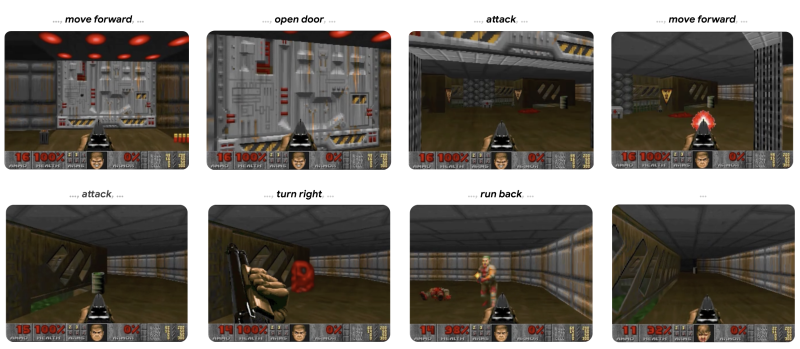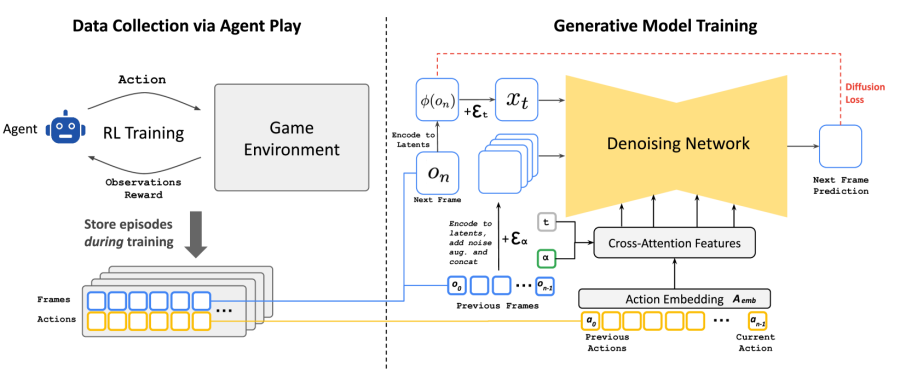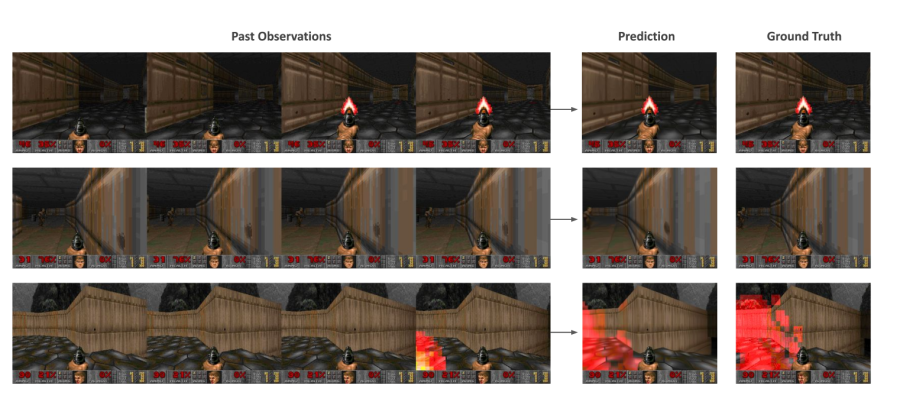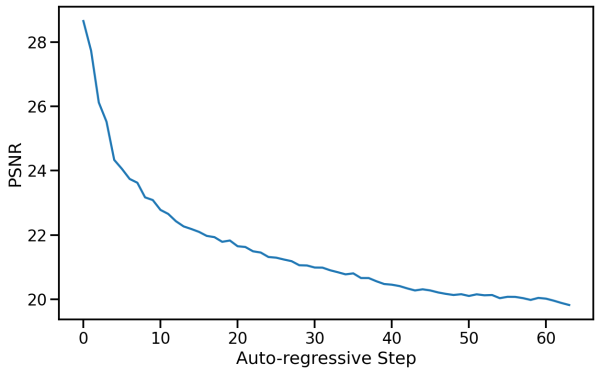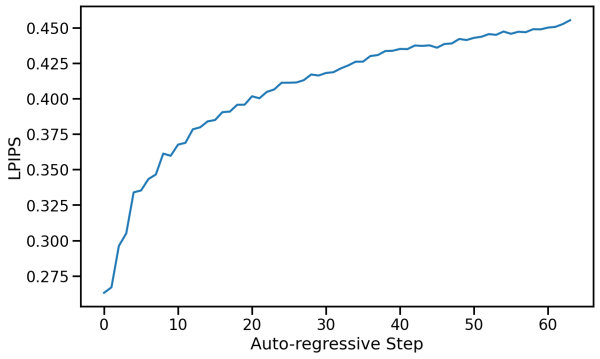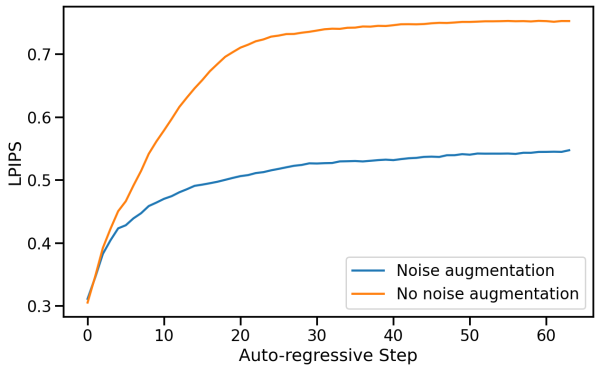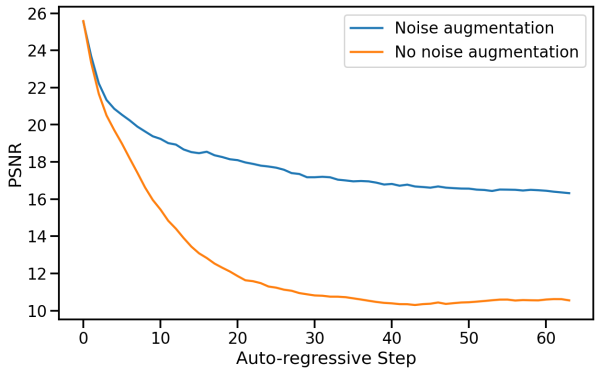扩散模型是实时游戏引擎
作者: Dani Valevski(谷歌研究)、Yaniv Leviathan(谷歌研究)、Moab Arar(特拉维夫大学)、Shlomi Fruchter(谷歌 DeepMind)
ArXiv链接: https://arxiv.org/abs/2408.14837
项目网站: https://gamengen.github.io
摘要
我们介绍了GameNGen,这是第一个完全由神经模型驱动的游戏引擎,能够在长轨迹上与复杂环境进行高质量的实时交互。GameNGen 可以在单个 TPU 上以每秒超过 20 帧的速度交互模拟经典游戏 DOOM。下一帧预测的 PSNR 为 29.4,与有损 JPEG 压缩相当。在区分游戏短片和模拟片段方面,人类评分员的表现仅略好于随机概率。GameNGen 的训练分为两个阶段:(1) 一个强化学习代理学习玩游戏,并记录训练过程;(2) 训练一个扩散模型,以过去的帧和动作序列为条件生成下一帧。条件增强技术可在长轨迹上实现稳定的自动回归生成。
请参见 https://gamengen.github.io 获取演示视频。
1 介绍
计算机游戏是围绕以下“游戏循环”手动制作的软件系统:(1) 收集用户输入,(2) 更新游戏状态,(3) 将其渲染为屏幕像素。这个游戏循环以很高的帧率运行,为玩家营造出一个交互式虚拟世界的假象。这种游戏循环通常在标准计算机上运行,尽管也有许多在定制硬件上运行游戏的惊人尝试(例如,标志性游戏《毁灭战士》曾在烤面包机、微波炉、跑步机、照相机、iPod 上运行,甚至在 Minecraft 游戏中运行——仅举几例,请参见 https://www.reddit.com/r/itrunsdoom/),但在所有这些情况下,硬件仍然是直接模拟手动编写的游戏软件。此外,尽管游戏引擎千差万别,但所有引擎中的游戏状态更新和渲染逻辑都是由一套手动编程或配置的规则组成的。
近年来,生成模型在根据文本或图像等多模态输入生成图像和视频方面取得了重大进展。在这一浪潮的前沿,扩散模型成为非语言媒体生成的事实标准,如 Dall-E(Ramesh 等人,2022)、Stable Diffusion(Rombach 等人,2022)和 Sora(Brooks 等人,2024)。乍一看,模拟视频游戏的交互世界似乎与视频生成类似。然而,"交互式"世界模拟不仅仅是快速生成视频。因为生成过程中需要以输入动作流为条件,而输入动作流只能在生成时获取,这打破了现有扩散模型架构的一些假设。尤其是,它要求自回归地生成帧,这往往是不稳定的,并导致采样发散(见 3.2.1 节)。
有几项重要研究(Ha & Schmidhuber,2018;Kim 等人,2020;Bruce 等人,2024)(见第6节)使用神经模型来模拟交互式视频游戏。然而,这些方法大多在模拟游戏的复杂性、仿真速度、长时间的稳定性或视觉质量等方面存在局限性(见图2)。因此,自然而然地会问:
一个实时运行的神经模型是否能够以高质量模拟复杂的游戏?
在这项工作中,我们证明答案是肯定的。具体来说,我们展示了一款复杂的视频游戏——标志性游戏《DOOM》,可以在神经网络(开放式 Stable Diffusion v1.4 的增强版(Rombach 等人,2022))上实时运行,同时获得与原始游戏相当的视觉质量。尽管这不是精确仿真,该神经模型能够执行复杂的游戏状态更新,例如统计生命值和弹药、攻击敌人、破坏物体、开门,以及在长轨迹上持续保持游戏状态。
GameNGen 回答了在通往游戏引擎新范式的道路上一个重要的问题,即游戏可以自动生成,就像近年来神经模型生成图像和视频一样。仍然存在关键问题,例如如何训练这些神经游戏引擎,以及如何有效地创建游戏,包括如何最佳地利用人类输入。尽管如此,我们对这种新范式的可能性感到非常兴奋。
2 互动世界仿真
一个交互环境由一个潜在状态空间、一个潜在空间的部分投影空间、一个部分投影函数、一组动作,以及一个转移概率函数,使得。
例如,在游戏 DOOM 中, 是程序的动态内存内容, 是渲染的屏幕像素, 是游戏的渲染逻辑, 是按键和鼠标移动的集合,而 是基于玩家输入的程序逻辑(包括任何潜在的非确定性)。
给定输入交互环境 和初始状态 ,一个“交互世界模拟”是一个“模拟分布函数” 。给定观测值之间的距离度量 ,一个“策略”,即给定过去动作和观测的代理动作分布 ,初始状态分布 和回合长度分布 ,交互世界模拟的目标是最小化 ,其中 ,,以及 是在执行代理策略 时从环境和模拟中抽取的观测值。重要的是,这些样本的条件动作总是通过代理与环境 交互获得,而条件观测既可以从 获得(“教师强迫目标”),也可以从模拟中获得(“自回归目标”)。
我们总是使用教师强迫目标来训练我们的生成模型。给定一个模拟分布函数 ,可以通过自回归地采样观测值来模拟环境 。
3 GameNGen
GameNGen(发音为“游戏引擎”)是一个生成扩散模型,它能够在第2节的设置下学习模拟游戏。为了收集该模型的训练数据,我们首先使用教师强制目标训练一个独立的模型与环境进行交互。这两个模型(代理和生成模型)依次进行训练。在训练过程中,代理的全部行为和观察语料 被保留下来,并在第二阶段成为生成模型的训练数据集。见图 3。
3.1 通过代理进行数据收集
我们的最终目标是让人类玩家与我们的仿真进行互动。为此,第2节中的策略即为“人类游戏策略”。由于我们无法直接大规模地从中取样,因此我们首先通过教一个自动代理来玩游戏,以此来近似人类游戏。与典型的强化学习设置不同,该设置旨在最大化游戏得分,我们的目标是生成与人类游戏类似的训练数据,或者至少在各种场景下包含足够多的多样化示例,以最大化训练数据的效率。为此,我们设计了一个简单的奖励函数,这是我们的方法中唯一与环境相关的部分(见附录A.3)。
我们在整个训练过程中记录了代理的训练轨迹,其中涵盖了不同技能水平的游戏。这组记录的轨迹构成了我们的数据集,用于训练生成模型(见第3.2节)。
3.2 训练生成扩散模型
现在,我们训练一个生成扩散模型,该模型以在前一阶段收集的代理轨迹(行动和观察)作为条件。
我们重新利用预训练的文本到图像扩散模型 Stable Diffusion v1.4(Rombach 等人,2022)。我们将模型 置于轨迹 的条件下,即在之前的动作 和观察(帧) 的序列条件下,并移除所有文本条件。具体来说,为了以动作为条件,我们仅需学习将每个动作(例如按下特定按键)嵌入为单个标记的 ,并将文本的交叉注意力替换为该编码动作序列。为了对观察(即之前的帧)进行条件化,我们使用自动编码器 将它们编码到潜在空间中,并在潜在通道维度中将它们串联到噪声潜在空间中(见图 3)。我们还尝试通过交叉注意力对这些过去的观察进行条件化,但没有观察到有意义的改进。
我们通过速度参数化训练模型,使得扩散损失最小化(Salimans & Ho, 2022b):
Failed to parse (syntax error): {\displaystyle \mathcal{L} = {{\mathbb{E}}_{t,\epsilon,T}\left\lbrack {\|{v{(\epsilon,x_{0},t)}} - {v_{\theta^{\prime}}{(x_{t},t,\{{\phi{(o_{i < n})}}\},\{{A_{emb}{(a_{i < n})}}\}})}}\|}_{2}^{2} \right\rbrack}} (1)
其中 Failed to parse (syntax error): {\displaystyle T = {\{ o_{i \leq n},a_{i \leq n}\}} \sim \mathcal{T}_{代理}} ,,,,,,而 是模型 的 v预测输出。噪声调度 是线性的,与 Rombach 等(2022)类似。
3.2.1 使用噪声增强缓解自回归漂移
如图4所示,教师强制训练和自动回归采样之间的领域偏移会导致误差积累和采样质量的快速下降。为了避免由于模型的自动回归应用而导致的这种偏差,我们在训练时向编码帧中添加不同程度的高斯噪声来扰动背景帧,并将噪声水平作为输入提供给模型,仿效 Ho 等人(2021)的方法。为此,我们对噪声水平 进行均匀采样,直至最大值,然后对其进行离散化,并为每个区间学习一个嵌入(见图3)。这使得网络能够纠正前几帧中的采样信息,对于长期保持帧质量至关重要。在推理过程中,可以控制添加的噪声水平以最大化质量,尽管我们发现,即使不添加噪声,结果也显著改善。我们将在5.2.2部分分析这种方法的影响。
3.2.2 潜在变量解码器微调
Stable Diffusion v1.4 的预训练自动编码器将 8x8 像素块压缩为 4 个潜通道,在预测游戏帧时会导致有意义的伪影,影响小细节,尤其是底栏 HUD(“抬头显示”)。为了在提高图像质量的同时利用预训练的知识,我们仅使用针对目标帧像素计算的 MSE 损失来训练潜在自动编码器的解码器。使用 LPIPS(Zhang 等人(2018))等感知损失可能会进一步提高质量,我们将其留待未来工作中研究。重要的是,请注意这个微调过程完全独立于 U-Net 微调过程,而且自回归生成不受其影响(我们仅对潜变量自回归地进行条件设置,而非像素)。附录 A.2 展示了对自动编码器进行微调和不进行微调的生成示例。
3.3 推理
3.3.1 设置
我们使用DDIM采样(Song等人,2022)。我们仅对过去观测条件采用了无分类器指导(Ho & Salimans,2022)。我们发现对过去动作条件的指导无法提高质量。我们使用的权重相对较小(1.5),因为较大的权重会产生伪影,而我们的自动回归采样则会放大这些伪影。
我们还尝试了同时生成 4 个样本并合并结果,希望能防止罕见的极端预测被采纳,并减少误差累积。我们尝试了对样本进行平均和选择最接近中位数的样本。平均效果略逊于单帧,而选择最接近中位数的样本效果仅略有提升。由于这两种方法都会将硬件需求提高到 4 个张量处理单元(TPU),因此我们决定不使用这些方法,但注意到这可能是未来研究的一个有趣领域。
3.3.2 去噪器采样步骤
在推理过程中,我们需要运行 U-Net 去噪器(进行若干步)和自动编码器。在我们的硬件配置(TPU-v5)下,一次去噪步骤和自动编码器的评估各需 10 毫秒。如果我们以单步去噪器运行模型,设置中的最小总延迟为每帧 20 毫秒,即每秒 50 帧。通常情况下,生成扩散模型(如 Stable Diffusion)通过单次去噪步骤无法产生高质量结果,而是需要数十个采样步骤才能生成高质量图像。令人惊讶的是,我们发现只需 4 个 DDIM 采样步骤,就能稳健地模拟 DOOM(Song 等人,2020)。实际上,我们观察到使用 4 步采样与使用 20 步或更多步采样相比,模拟质量没有下降(见附录 A.4)。
仅使用 4 个去噪步骤导致 U-Net 总耗时为 40 毫秒(包括自动编码器的推理总耗时为 50 毫秒),即每秒 20 帧。我们推测,在我们的案例中,较少步骤对质量影响可忽略不计,是由于以下因素的结合:(1) 受限的图像空间,以及 (2) 前一帧的强条件作用。
由于我们在使用单步采样时确实观察到了质量下降,因此我们在单步设置中进行了类似于(Yin 等人,2024;Wang 等人,2023)的模型蒸馏实验。蒸馏确实有很大帮助(使我们达到了上述的 50 FPS),但仍会对仿真质量造成一定影响,因此我们选择在我们的方法中使用不带蒸馏的 4 步版本(见附录 A.4)。这是一个值得进一步研究的有趣领域。
我们注意到,类似于 NVidia 的经典 SLI 交替帧渲染(AFR)技术,通过在额外硬件上并行生成多个帧,可以显著提高图像生成速率。然而,与 AFR 类似,实际的仿真速率不会提高,输入延迟也不会减少。
4 实验设置
4.1 代理训练
代理模型使用 PPO(Schulman 等人,2017)进行训练,采用简单的 CNN 作为特征网络,基于 Mnih 等人(2015)的方法。在 CPU 上使用 Stable Baselines 3 基础架构(Raffin 等人,2021)进行训练。代理接收缩小后的帧图像和游戏地图,每个分辨率为 160x120。代理还可以访问其最近执行的 32 次动作。特征网络为每幅图像计算出大小为 512 的表示。PPO 的 actor 和 critic 是基于图像特征网络输出和过去动作序列连接的两层 MLP 头。我们使用 Vizdoom 环境(Wydmuch 等人,2019)训练代理来玩游戏。我们并行运行了 8 个游戏,每个游戏的回放缓冲区大小为 512,折扣因子为 ,熵系数为 。在每次迭代中,我们使用批量大小为 64 的数据进行 10 个时代的训练,学习率为 1e-4。我们总共执行了 1000 万个环境步骤。
4.2 生成模型训练
我们使用 Stable Diffusion 1.4 的预训练检查点训练所有仿真模型,解冻所有 U-Net 参数。我们使用的批量大小为 128,恒定学习率为 2e-5,采用无权重衰减的 Adafactor 优化器(Shazeer & Stern,2018),以及梯度剪切为 1.0。我们将扩散损失参数化更改为 v预测(Salimans & Ho 2022a)。我们以 0.1 的概率去掉上下文帧条件,以便在推理过程中使用 CFG。我们使用 128 台 TPU-v5e 设备进行数据并行化训练。除非另有说明,本文中的所有结果均为 700,000 步训练后的结果。对于噪声增强(第3.2.1节),我们使用的最大噪声水平为 0.7,并设有 10 个嵌入桶。在优化潜在解码器时,我们使用的批次大小为 2,048;其他训练参数与去噪器的参数相同。在训练数据方面,除非另有说明,我们使用了代理在强化学习训练期间的所有轨迹以及训练期间的评估数据。总体而言,我们生成了 9 亿帧用于训练。所有图像帧(在训练、推理和条件期间)的分辨率均为 320x240,并填充为 320x256。我们使用的上下文长度为 64(即向模型提供其自身的最后 64 次预测以及最后 64 次操作)。
5 结果
5.1 仿真质量
总体而言,从图像质量来看,我们的方法在长轨迹上实现了与原始游戏相当的仿真质量。对于短轨迹,人类评估者在区分仿真片段和实际游戏片段时,仅比随机猜测略胜一筹。
图像质量。 我们使用第2节中描述的教师强迫设置来测量LPIPS(Zhang 等人,2018)和PSNR。在该设置中,我们对初始状态进行采样,并根据地面实况的过去观察轨迹预测单帧。在对5个不同级别的2048条随机轨迹进行评估时,我们的模型实现了的PSNR值和的LPIPS值。PSNR值与质量设置为20-30的有损JPEG压缩相似(Petric & Milinkovic,2018)。图5展示了模型预测和相应地面实况样本的示例。
视频质量 我们使用第2节中描述的自回归设置,按照真实轨迹所定义的动作序列对帧进行迭代采样,同时将模型自身的过往预测作为条件。自回归采样时,预测轨迹和真实轨迹常常在几步后发生偏离,这主要是由于不同轨迹的帧间积累了少量不同的运动速度。因此,如图6所示,每帧的PSNR和LPIPS值分别逐渐降低和增加。预测的轨迹在内容和图像质量方面仍与实际游戏相似,但每帧指标在捕捉这一点的能力上有限(自动回归生成的轨迹样本见附录A.1)。
因此,我们对512个随机保留的轨迹计算FVD(Unterthiner等人,2019),测量预测轨迹分布与真实值轨迹分布之间的距离,仿真的长度为16帧(0.8秒)和32帧(1.6秒)。对于16帧,我们的模型获得的FVD为。对于32帧,我们的模型获得的FVD为。
人类评估。 作为评估仿真质量的另一项标准,我们向 10 名评测员提供了 130 个随机短片段(长度为 1.6 秒和 3.2 秒),并排展示我们的仿真和真实游戏。评测员的任务是识别真实游戏(见附录A.6中的图14)。评测员在 1.6 秒和 3.2 秒的片段中,选择真实游戏而非仿真的比例分别为 58% 和 60%。
5.2 消融实验
为了评估我们方法中不同组件的重要性,我们从评估数据集中采样轨迹,并计算真实值与预测帧之间的 LPIPS 和 PSNR 指标。
5.2.1 上下文长度
我们通过训练使用的模型来评估改变条件上下文中过去观测值数量的影响(请注意,我们的方法使用)。这影响了历史帧和动作的数量。我们在解码器保持冻结的情况下训练模型200,000步,并在5个级别的测试集轨迹上进行评估。结果见表1。正如预期的那样,我们发现生成质量随着上下文长度的增加而提高。有趣的是,我们观察到,尽管最初(例如在1到2帧之间)提升较大,但很快就接近一个渐近线,进一步增加上下文长度只能带来微小的质量提升。这有些令人惊讶,因为即使在我们使用的最大上下文长度下,模型也只能访问略多于3秒的历史。值得注意的是,我们观察到大部分游戏状态会持续更长时间(见第7节)。虽然条件上下文长度是一个重要的限制,但表1提示我们可能需要改变模型的架构,以有效支持更长的上下文,并更好地选择过去的帧作为条件,这将是我们未来的工作。
表 1:历史帧数量。我们在来自 5 个级别的 8912 个测试集示例中分析了用作上下文的历史帧数量。更多的帧通常会改善 PSNR 和 LPIPS 指标。
| 历史上下文长度 | PSNR | LPIPS |
|---|---|---|
| 64 | ||
| 32 | ||
| 16 | ||
| 8 | ||
| 4 | ||
| 2 | ||
| 1 |
5.2.2 噪声增强
为了消除噪声增强的影响,我们训练了一个不添加噪声的模型。我们对标准噪声增强模型和不添加噪声的模型(经过 200,000 步训练后)进行自回归评估,并计算在随机保留的 512 条轨迹上预测帧与真实帧之间的 PSNR 和 LPIPS 指标。我们在图 7 中报告了每个自回归步骤的平均指标值,最多可达 64 帧。
在没有噪声增强的情况下,与真实值相比,LPIPS 距离迅速增加,而 PSNR 下降,这表明仿真结果与真实值的偏差加大。
5.2.3 代理执行
我们将代理生成的数据训练与使用随机策略生成的数据训练进行比较。对于随机策略,我们根据与观测结果无关的均匀分类分布对动作进行采样。我们通过对两个模型及其解码器进行
总体而言,我们观察到在随机轨迹上训练模型的效果出奇地好,但受到随机策略探索能力的限制。在比较单帧生成时,代理的效果稍好,PSNR 为 25.06,而随机策略为 24.42。在比较 3 秒自回归生成后的帧时,差距增大到 19.02 对 16.84。在手动操作模型时,我们发现某些区域对两者都很容易,而某些区域对两者都很困难,而在某些区域,代理的表现要好得多。基于此,我们根据它们与游戏起始位置的距离手动将 456 个例子分为三组:易、中等和难。我们观察到,在简单和困难集上,代理的表现仅略优于随机,而在中等集上,正如预期的那样,代理的表现要好得多(见表 2)。请参见附录 A.5 中的图 13,了解人类单次游戏的得分情况。
表 2:不同难度级别的表现。 我们比较了使用代理生成数据和随机生成数据训练的模型在简单、中等和困难数据集上的表现。简单和中等数据集各有 112 个样本,困难数据集有 232 个样本。在 3 秒后的单帧上计算每个轨迹的指标。
| 难度级别 | 数据生成策略 | PSNR | LPIPS |
|---|---|---|---|
| 简单 | 代理 | ||
| 随机 | |||
| 中等 | 代理 | ||
| 随机 | |||
| 困难 | 代理 | ||
| 随机 |
6 相关工作
交互式三维仿真
模拟二维和三维环境的视觉和物理过程,并允许对其进行交互式探索,是计算机图形学中一个广泛发展的领域(Akenine-Möller等人,2018)。像虚幻和Unity这样的游戏引擎是可以处理场景几何表示并根据用户交互渲染图像流的软件。游戏引擎负责跟踪所有世界状态,例如玩家的位置和移动、物体、角色动画和光照。它还负责跟踪游戏逻辑,例如完成游戏目标所获得的分数。电影和电视制作使用的光线追踪变体(Shirley和Morley,2008),对于实时应用来说过于缓慢且计算密集。相比之下,游戏引擎必须保持非常高的帧率(通常为30-60 FPS),因此依赖于高度优化的多边形光栅化,并且通常由GPU加速。诸如阴影、粒子和光照等物理效果通常使用高效的启发式方法来实现,而不是进行精确的物理仿真。
神经三维仿真
重建三维表示的神经方法在过去几年中取得了重大进展。NeRFs(Mildenhall 等人,2020)使用深度神经网络对辐射场进行参数化,该网络针对从不同相机姿态拍摄的一组图像的特定场景进行了专门优化。训练完成后,可通过体积渲染方法对场景的新视角进行采样。Gaussian Splatting(Kerbl 等人,2023)方法建立在 NeRFs 的基础上,但使用三维高斯和改进的光栅化方法来表示场景,从而实现更快的训练和渲染速度。尽管这些方法展示了令人印象深刻的重建结果和实时交互性,但通常仅限于静态场景。
视频扩散模型
Diffusion models achieved state-of-the-art results in text-to-image generation (Saharia et al., 2022; Rombach et al., 2022; Ramesh et al., 2022; Podell et al., 2023), a line of work that has also been applied for text-to-video generation tasks (Ho et al., 2022; Blattmann et al., 2023b; a; Gupta et al., 2023; Girdhar et al., 2023; Bar-Tal et al., 2024). Despite impressive advancements in realism, text adherence, and temporal consistency, video diffusion models remain too slow for real-time applications. Our work extends this line of work and adapts it for real-time generation conditioned autoregressively on a history of past observations and actions.
Game Simulation and World Models
Several works attempted to train models for game simulation with actions inputs. Yang et al. (2023) build a diverse dataset of real-world and simulated videos and train a diffusion model to predict a continuation video given a previous video segment and a textual description of an action. Menapace et al. (2021) and Bruce et al. (2024) focus on unsupervised learning of actions from videos. Menapace et al. (2024) converts textual prompts to game states, which are later converted to a 3D representation using NeRF. Unlike these works, we focus on interactive playable real-time simulation, and demonstrate robustness over long-horizon trajectories. We leverage an RL agent to explore the game environment and create rollouts of observations and interactions for training our interactive game model. Another line of work explored learning a predictive model of the environment and using it for training an RL agent. Ha & Schmidhuber (2018) train a Variational Auto-Encoder (Kingma & Welling, 2014) to encode game frames into a latent vector, and then use an RNN to mimic the VizDoom game environment, training on random rollouts from a random policy (i.e., selecting an action at random). Then a controller policy is learned by playing within the “hallucinated” environment. Hafner et al. (2020) demonstrate that an RL agent can be trained entirely on episodes generated by a learned world model in latent space. Also close to our work is Kim et al. (2020), which uses an LSTM architecture for modeling the world state, coupled with a convolutional decoder for producing output frames and jointly trained under an adversarial objective. While this approach seems to produce reasonable results for simple games like PacMan, it struggles with simulating the complex environment of VizDoom and produces blurry samples. In contrast, GameNGen is able to generate samples comparable to those of the original game; see Figure 2. Finally, concurrently with our work, Alonso et al. (2024) train a diffusion world model to predict the next observation given observation history, and iteratively train the world model and an RL model on Atari games.
DOOM
When DOOM was released in 1993, it revolutionized the gaming industry. Introducing groundbreaking 3D graphics technology, it became a cornerstone of the first-person shooter genre, influencing countless other games. DOOM was studied by numerous research works. It provides an open-source implementation and a native resolution that is low enough for small-sized models to simulate while being complex enough to be a challenging test case. Finally, the authors have spent countless youth hours with the game. It was a trivial choice to use it in this work.
7 Discussion
Summary. We introduced GameNGen and demonstrated that high-quality real-time gameplay at 20 frames per second is possible on a neural model. We also provided a recipe for converting an interactive piece of software such as a computer game into a neural model.
Limitations. GameNGen suffers from a limited amount of memory. The model only has access to a little over 3 seconds of history, so it’s remarkable that much of the game logic is persisted for drastically longer time horizons. While some of the game state is persisted through screen pixels (e.g., ammo and health tallies, available weapons, etc.), the model likely learns strong heuristics that allow meaningful generalizations. For example, from the rendered view, the model learns to infer the player’s location, and from the ammo and health tallies, the model might infer whether the player has already been through an area and defeated the enemies there. That said, it’s easy to create situations where this context length is not enough. Continuing to increase the context size with our existing architecture yields only marginal benefits (Section 5.2.1), and the model’s short context length remains an important limitation. The second important limitation is the remaining differences between the agent’s behavior and those of human players. For example, our agent, even at the end of training, still does not explore all of the game’s locations and interactions, leading to erroneous behavior in those cases.
Future Work. We demonstrate GameNGen on the classic game DOOM. It would be interesting to test it on other games or more generally on other interactive software systems. We note that nothing in our technique is DOOM specific except for the reward function for the RL-agent. We plan on addressing that in future work. While GameNGen manages to maintain game state accurately, it isn’t perfect, as per the discussion above. A more sophisticated architecture might be needed to mitigate these issues. GameNGen currently has a limited capability to leverage more than a minimal amount of memory. Experimenting with further expanding the memory effectively could be critical for more complex games/software. GameNGen runs at 20 or 50 FPS22Faster than the original game DOOM ran on some of the authors’ 80386 machines at the time! on a TPUv5. It would be interesting to experiment with further optimization techniques to get it to run at higher frame rates and on consumer hardware.
Towards a New Paradigm for Interactive Video Games. Today, video games are programmed by humans. GameNGen is a proof-of-concept for one part of a new paradigm where games are weights of a neural model, not lines of code. GameNGen shows that an architecture and model weights exist such that a neural model can effectively run a complex game (DOOM) interactively on existing hardware. While many important questions remain, we are hopeful that this paradigm could have important benefits. For example, the development process for video games under this new paradigm might be less costly and more accessible, whereby games could be developed and edited via textual descriptions or example images. A small part of this vision, namely creating modifications or novel behaviors for existing games, might be achievable in the shorter term. For example, we might be able to convert a set of frames into a new playable level or create a new character just based on example images, without having to author code. Other advantages of this new paradigm include strong guarantees on frame rates and memory footprints. We have not experimented with these directions yet and much more work is required here, but we are excited to try! Hopefully, this small step will someday contribute to a meaningful improvement in people’s experience with video games, or maybe even more generally, in day-to-day interactions with interactive software systems.
Acknowledgements
We’d like to extend a huge thank you to Eyal Segalis, Eyal Molad, Matan Kalman, Nataniel Ruiz, Amir Hertz, Matan Cohen, Yossi Matias, Yael Pritch, Danny Lumen, Valerie Nygaard, the Theta Labs and Google Research teams, and our families for insightful feedback, ideas, suggestions, and support.
Contribution
- Dani Valevski: Developed much of the codebase, tuned parameters and details across the system, added autoencoder fine-tuning, agent training, and distillation.
- Yaniv Leviathan: Proposed project, method, and architecture, developed the initial implementation, key contributor to implementation and writing.
- Moab Arar: Led auto-regressive stabilization with noise-augmentation, many of the ablations, and created the dataset of human-play data.
- Shlomi Fruchter: Proposed project, method, and architecture. Project leadership, initial implementation using DOOM, main manuscript writing, evaluation metrics, random policy data pipeline.
Correspondence to shlomif@google.com and leviathan@google.com.
References
- Akenine-Möller et al. (2018) Tomas Akenine-Möller, Eric Haines, and Naty Hoffman. Real-Time Rendering, Fourth Edition. A. K. Peters, Ltd., USA, 4th edition, 2018. ISBN 0134997832.
- Alonso et al. (2024) Eloi Alonso, Adam Jelley, Vincent Micheli, Anssi Kanervisto, Amos Storkey, Tim Pearce, and François Fleuret. Diffusion for world modeling: Visual details matter in Atari, 2024.
- Bar-Tal et al. (2024) Omer Bar-Tal, Hila Chefer, Omer Tov, Charles Herrmann, Roni Paiss, Shiran Zada, Ariel Ephrat, Junhwa Hur, Guanghui Liu, Amit Raj, Yuanzhen Li, Michael Rubinstein, Tomer Michaeli, Oliver Wang, Deqing Sun, Tali Dekel, and Inbar Mosseri. Lumiere: A space-time diffusion model for video generation, 2024. URL: [1](https://arxiv.org/abs/2401.12945).
- Blattmann et al. (2023a) Andreas Blattmann, Tim Dockhorn, Sumith Kulal, Daniel Mendelevitch, Maciej Kilian, Dominik Lorenz, Yam Levi, Zion English, Vikram Voleti, Adam Letts, Varun Jampani, and Robin Rombach. Stable video diffusion: Scaling latent video diffusion models to large datasets, 2023a. URL: [2](https://arxiv.org/abs/2311.15127).
- Blattmann et al. (2023b) Andreas Blattmann, Robin Rombach, Huan Ling, Tim Dockhorn, Seung Wook Kim, Sanja Fidler, and Karsten Kreis. Align your latents: High-resolution video synthesis with latent diffusion models, 2023b. URL: [3](https://arxiv.org/abs/2304.08818).
- Brooks et al. (2024) Tim Brooks, Bill Peebles, Connor Holmes, Will DePue, Yufei Guo, Li Jing, David Schnurr, Joe Taylor, Troy Luhman, Eric Luhman, Clarence Ng, Ricky Wang, and Aditya Ramesh. Video generation models as world simulators, 2024. URL: [4](https://openai.com/research/video-generation-models-as-world-simulators).
- Bruce et al. (2024) Jake Bruce, Michael Dennis, Ashley Edwards, Jack Parker-Holder, Yuge Shi, Edward Hughes, Matthew Lai, Aditi Mavalankar, Richie Steigerwald, Chris Apps, Yusuf Aytar, Sarah Bechtle, Feryal Behbahani, Stephanie Chan, Nicolas Heess, Lucy Gonzalez, Simon Osindero, Sherjil Ozair, Scott Reed, Jingwei Zhang, Konrad Zolna, Jeff Clune, Nando de Freitas, Satinder Singh, and Tim Rocktäschel. Genie: Generative interactive environments, 2024. URL: [5](https://arxiv.org/abs/2402.15391).
- Girdhar et al. (2023) Rohit Girdhar, Mannat Singh, Andrew Brown, Quentin Duval, Samaneh Azadi, Sai Saketh Rambhatla, Akbar Shah, Xi Yin, Devi Parikh, and Ishan Misra. Emu video: Factorizing text-to-video generation by explicit image conditioning, 2023. URL: [6](https://arxiv.org/abs/2311.10709).
- Gupta et al. (2023) Agrim Gupta, Lijun Yu, Kihyuk Sohn, Xiuye Gu, Meera Hahn, Li Fei-Fei, Irfan Essa, Lu Jiang, and José Lezama. Photorealistic video generation with diffusion models, 2023. URL: [7](https://arxiv.org/abs/2312.06662).
- Ha & Schmidhuber (2018) David Ha and Jürgen Schmidhuber. World models, 2018.
- Hafner et al. (2020) Danijar Hafner, Timothy Lillicrap, Jimmy Ba, and Mohammad Norouzi. Dream to control: Learning behaviors by latent imagination, 2020. URL: [8](https://arxiv.org/abs/1912.01603).
- Ho & Salimans (2022) Jonathan Ho and Tim Salimans. Classifier-free diffusion guidance, 2022. URL: [9](https://arxiv.org/abs/2207.12598).
- Ho et al. (2021) Jonathan Ho, Chitwan Saharia, William Chan, David J Fleet, Mohammad Norouzi, and Tim Salimans. Cascaded diffusion models for high fidelity image generation. arXiv preprint arXiv:2106.15282, 2021.
- Ho et al. (2022) Jonathan Ho, William Chan, Chitwan Saharia, Jay Whang, Ruiqi Gao, Alexey A. Gritsenko, Diederik P. Kingma, Ben Poole, Mohammad Norouzi, David J. Fleet, and Tim Salimans. Imagen video: High definition video generation with diffusion models. ArXiv, abs/2210.02303, 2022. URL: [10](https://api.semanticscholar.org/CorpusID:252715883).
- Kerbl et al. (2023) Bernhard Kerbl, Georgios Kopanas, Thomas Leimkühler, and George Drettakis. 3d gaussian splatting for real-time radiance field rendering. ACM Transactions on Graphics, 42(4), July 2023. URL: [11](https://repo-sam.inria.fr/fungraph/3d-gaussian-splatting/).
- Kim et al. (2020) Seung Wook Kim, Yuhao Zhou, Jonah Philion, Antonio Torralba, and Sanja Fidler. Learning to Simulate Dynamic Environments with GameGAN. In IEEE Conference on Computer Vision and Pattern Recognition (CVPR), Jun. 2020.
- Kingma & Welling (2014) Diederik P. Kingma and Max Welling. Auto-Encoding Variational Bayes. In 2nd International Conference on Learning Representations, ICLR 2014, Banff, AB, Canada, April 14-16, 2014, Conference Track Proceedings, 2014.
- Menapace et al. (2021) Willi Menapace, Stéphane Lathuilière, Sergey Tulyakov, Aliaksandr Siarohin, and Elisa Ricci. Playable video generation, 2021. URL: [12](https://arxiv.org/abs/2101.12195).
- Menapace et al. (2024) Willi Menapace, Aliaksandr Siarohin, Stéphane Lathuilière, Panos Achlioptas, Vladislav Golyanik, Sergey Tulyakov, and Elisa Ricci. Promptable game models: Text-guided game simulation via masked diffusion models. ACM Transactions on Graphics, 43(2):1–16, January 2024. doi: [10.1145/3635705](http://dx.doi.org/10.1145/3635705).
- Mildenhall et al. (2020) Ben Mildenhall, Pratul P. Srinivasan, Matthew Tancik, Jonathan T. Barron, Ravi Ramamoorthi, and Ren Ng. Nerf: Representing scenes as neural radiance fields for view synthesis. In ECCV, 2020.
- Mnih et al. (2015) Volodymyr Mnih, Koray Kavukcuoglu, David Silver, Andrei A. Rusu, Joel Veness, Marc G. Bellemare, Alex Graves, Martin A. Riedmiller, Andreas Kirkeby Fidjeland, Georg Ostrovski, Stig Petersen, Charlie Beattie, Amir Sadik, Ioannis Antonoglou, Helen King, Dharshan Kumaran, Daan Wierstra, Shane Legg, and Demis Hassabis. Human-level control through deep reinforcement learning. Nature, 518:529–533, 2015. URL: [13](https://api.semanticscholar.org/CorpusID:205242740).
- Petric & Milinkovic (2018) Danko Petric and Marija Milinkovic. Comparison between cs and jpeg in terms of image compression, 2018. URL: [14](https://arxiv.org/abs/1802.05114).
- Podell et al. (2023) Dustin Podell, Zion English, Kyle Lacey, Andreas Blattmann, Tim Dockhorn, Jonas Müller, Joe Penna, and Robin Rombach. Sdxl: Improving latent diffusion models for high-resolution image synthesis. arXiv preprint arXiv:2307.01952, 2023.
- Raffin et al. (2021) Antonin Raffin, Ashley Hill, Adam Gleave, Anssi Kanervisto, Maximilian Ernestus, and Noah Dormann. Stable-baselines3: Reliable reinforcement learning implementations. Journal of Machine Learning Research, 22(268):1–8, 2021. URL: [15](http://jmlr.org/papers/v22/20-1364.html).
- Ramesh et al. (2022) Aditya Ramesh, Prafulla Dhariwal, Alex Nichol, Casey Chu, and Mark Chen. Hierarchical text-conditional image generation with clip latents. arXiv preprint arXiv:2204.06125, 2022.
- Rombach et al. (2022) Robin Rombach, Andreas Blattmann, Dominik Lorenz, Patrick Esser, and Björn Ommer. High-resolution image synthesis with latent diffusion models. In Proceedings of the IEEE/CVF conference on computer vision and pattern recognition, pp. 10684–10695, 2022.
- Saharia et al. (2022) Chitwan Saharia, William Chan, Saurabh Saxena, Lala Li, Jay Whang, Emily L Denton, Kamyar Ghasemipour, Raphael Gontijo Lopes, Burcu Karagol Ayan, Tim Salimans, et al. Photorealistic text-to-image diffusion models with deep language understanding. Advances in Neural Information Processing Systems, 35:36479–36494, 2022.
- Salimans & Ho (2022a) Tim Salimans and Jonathan Ho. Progressive distillation for fast sampling of diffusion models. In The Tenth International Conference on Learning Representations, ICLR 2022, Virtual Event, April 25-29, 2022. OpenReview.net, 2022a. URL: [16](https://openreview.net/forum?id=TIdIXIpzhoI).
- Salimans & Ho (2022b) Tim Salimans and Jonathan Ho. Progressive distillation for fast sampling of diffusion models, 2022b. URL: [17](https://arxiv.org/abs/2202.00512).
- Schulman et al. (2017) John Schulman, Filip Wolski, Prafulla Dhariwal, Alec Radford, and Oleg Klimov. Proximal policy optimization algorithms. CoRR, abs/1707.06347, 2017. URL: [18](http://arxiv.org/abs/1707.06347).
- Shazeer & Stern (2018) Noam Shazeer and Mitchell Stern. Adafactor: Adaptive learning rates with sublinear memory cost. CoRR, abs/1804.04235, 2018. URL: [19](http://arxiv.org/abs/1804.04235).
- Shirley & Morley (2008) P. Shirley and R.K. Morley. Realistic Ray Tracing, Second Edition. Taylor & Francis, 2008. ISBN 9781568814612. URL: [20](https://books.google.ch/books?id=knpN6mnhJ8QC).
- Song et al. (2020) Jiaming Song, Chenlin Meng, and Stefano Ermon. Denoising diffusion implicit models. arXiv:2010.02502, October 2020. URL: [21](https://arxiv.org/abs/2010.02502).
- Song et al. (2022) Jiaming Song, Chenlin Meng, and Stefano Ermon. Denoising diffusion implicit models, 2022. URL: [22](https://arxiv.org/abs/2010.02502).
- Unterthiner et al. (2019) Thomas Unterthiner, Sjoerd van Steenkiste, Karol Kurach, Raphaël Marinier, Marcin Michalski, and Sylvain Gelly. FVD: A new metric for video generation. In Deep Generative Models for Highly Structured Data, ICLR 2019 Workshop, New Orleans, Louisiana, United States, May 6, 2019, 2019.
- Wang et al. (2023) Zhengyi Wang, Cheng Lu, Yikai Wang, Fan Bao, Chongxuan Li, Hang Su, and Jun Zhu. Prolificdreamer: High-fidelity and diverse text-to-3d generation with variational score distillation. arXiv preprint arXiv:2305.16213, 2023.
- Wydmuch et al. (2019) Marek Wydmuch, Michał Kempka, and Wojciech Jaśkowski. ViZDoom Competitions: Playing Doom from Pixels. IEEE Transactions on Games, 11(3):248–259, 2019. doi: [10.1109/TG.2018.2877047](http://dx.doi.org/10.1109/TG.2018.2877047).
- Yang et al. (2023) Mengjiao Yang, Yilun Du, Kamyar Ghasemipour, Jonathan Tompson, Dale Schuurmans, and Pieter Abbeel. Learning interactive real-world simulators. arXiv preprint arXiv:2310.06114, 2023.
- Yin et al. (2024) Tianwei Yin, Michaël Gharbi, Richard Zhang, Eli Shechtman, Frédo Durand, William T Freeman, and Taesung Park. One-step diffusion with distribution matching distillation. In CVPR, 2024.
- Zhang et al. (2018) Richard Zhang, Phillip Isola, Alexei A. Efros, Eli Shechtman, and Oliver Wang. The unreasonable effectiveness of deep features as a perceptual metric. In CVPR, 2018.
Appendix A Appendix
A.1 Samples
Figs. [8](https://arxiv.org/html/2408.14837v1#A1.F8), [9](https://arxiv.org/html/2408.14837v1#A1.F9), [10](https://arxiv.org/html/2408.14837v1#A1.F10), [11](https://arxiv.org/html/2408.14837v1#A1.F11) provide selected samples from GameNGen.
